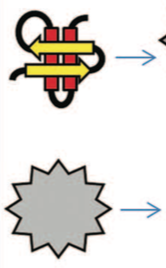jasu
1
Kawakami is a material scientist who created amazing protein models that show both the interior and exterior structures using a full color print and silicone, respectively.
To produce such a model one needs to print a model of the internal ribbon structure and an outside mold. This is then used to pour in liquid silicone to create the exterior surface.
He published a detailed description of the process in 2012:
Kawakami12 surface+ribbon.pdf.
Is anybody brave enough to attempt to create such a model for glucokinase?
Here are the models for the interior glucokinase ribbon v4.wrl and the exterior surface glucokinase surface v3.wrl , equivalent to this step in the process:

Kawakami12 surface+ribbon_0.pdf (1.13 MB)
glucokinase ribbon v4.wrl (12.1 MB)
glucokinase surface v3.wrl (6.11 MB)
2 Likes
Chiel
2
Hi jasu,
I’m able to create this model if you’d like.
After all, I model stuff all the time for a living.
Can you provide the preferred shell and support thickness?
Is there a tight time schedule?
You can contact me via email: chielsaro@gmail.com
Best regards,
Chiel
1 Like
jasu
3
Hi Chiel,
Thanks for the reply. Where are you based? I’m guessing Hasselt, Belgium from the scant info on you user page. What have you printed/modeled in the past? Which printer would you use?
Schedule is relaxed as this is quite experimental and also more time consuming than your average Jo’s 3D model.
Regards
Chiel
4
Hi Jasu,
Yes, I am located in Hasselt, Belgium.
I’ve done a lot of different modeling in the past.
From models for animation and film to games and even 3D printing and virtual reality.
I don’t have a lot of examples to show you as most of my work has been done under an NDA.
But don’t worry, I haven’t seen a model yet I could not replicate. (provided enough time of course)
I understand it’s not so much about creating a new model but mostly cleaning the models you provided.
For choice of printer I’d recommend one of the new full-color plastic printers. (not sure if 3dhubs is providing this option yet)
If you’d choose sandstone, the finish might be quite rough on the inside as they are hard to reach places to polish.
This however is only for full color prints.
For a single color print I’d recommend looking in to stereolithography (SLA) because of the high resolution you can achieve.
regards,
Chiel
jasu
5
Hi Chiel,
Color makes these models much more instructive.
Yes, the rough surface of sandstone was a problem in the original pilots by Kawakami (see his article). Multi-color plastic would be better if smoother. Shapeways discontinued this printer type because of complications. Does this work?
So, you could model but not print and produce? Am I understanding this correctly?
All the best
Chiel
6
Yes, that is correct. I personally have an ultimaker but it is not registered with 3d hubs.
Hello there, it’s good to know there are also someone who is trying with the Kawakami model.
I am currently being very “ambitious” with a nucleoprotein complex, Cascade, which makes up of 12 units (PDBe: 4tvx); (PDB 4tvx structure summary ‹ Protein Data Bank in Europe (PDBe) ‹ EMBL-EBI). And so far it has been very problematic.
-I managed to split the complex into individual proteins (in pdb), but somehow Chimera is refusing to generate the surface; I went for pymol which generated the surface, yet refused to save in VRML format with my student version(i.e. free edition). I am now working with VMD and hopefully will be able to create these files.
Anyway, i would love to hear you guy’s experience with the Kawakami model so far
1) Any replacement of CADs programme? I got the free version of Magic (Materialise, Leuven), minimagic; I have not tried it out yet so I am not sure whether it will contain the “hollow” function. There is also probably a need to look for a free replacement for Rhinoceros 3D (Robert McNeel & Associates, Seattle).
2) I looked into the youtube channel of Kawakami (- YouTube) and managed to check his provider for the printings (http://www.studio-midas.com/). The used Zpainter 450 has some advantages in building this sort of model, most importantly there is no need for support unlike the usual PLA machine; However, the painting seems to be damn expensive (20,000 yen for a 7x9x10cm model; say roughly a 150 euros). I wonder how the SLA is going and I might also attempt in this direction.
“…For a single color print I’d recommend looking in to stereolithography (SLA) because of the high resolution you can achieve…”
will be cool to hear from u guys.